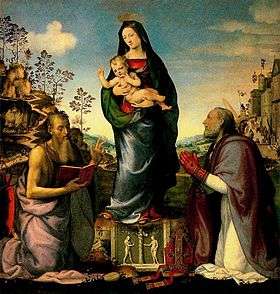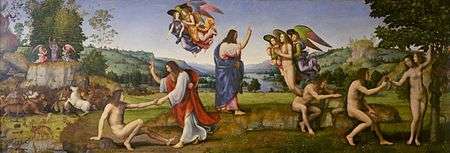Mariotto Albertinelli
| Mariotto Albertinelli | |
|---|---|
 The Visitation | |
| Born |
13 October 1474 Florence |
| Died | 5 November 1515 |
| Nationality | Italian |
| Known for | Painting |
| Movement | High Renaissance |
Mariotto Albertinelli, in full Mariotto di Bigio di Bindo Albertinelli (13 October 1474 – 5 November 1515) was an Italian High Renaissance painter of the Florentine school. He was a close friend and collaborator of Fra Bartolomeo and their joint works appear as if they have been painted by one hand.[1]
His work shows the influence of Perugino, Piero di Cosimo and Lorenzo di Credi as well as of Flemish painting.[1][2] Some of Albertinelli's works reveal an eccentrically archaic tendency while others show a return to conventions of the early Renaissance.[1]
Life
Mariotto Albertinelli was born in Florence as the son of a gold beater. He was an only child and his mother died when he was just five years old.[3] He was himself trained as a gold beater until the age of 12 when he became a pupil of Cosimo Rosselli and a fellow-pupil with Fra Bartolomeo. The two pupils formed such a close friendship that in 1494 they started a joint studio in Florence. After a while Albertinelli had mastered Fra Bartolommeo’s technique to such extent that he could paint in a style that blended with that of his partner.[1] The closeness in style was such that for many years some doubts remained over who had painted certain works. For example, the Kress tondo now in the Columbia Museum of Art was given to Fra Bartolommeo but is now thought to be the work of Albertinelli using the former's cartoon.[4]

According to the early Italian biographer Vasari, Albertinelli was in the beginning of his career exclusively working for Alfonsina Orsini, the wife of Piero II de’ Medici and mother of Lorenzo II de' Medici.[5] His early works were small paintings destined for the homes of sophisticated patrons. He produced these works independently of Fra Bartolommeo and as a result they are stylistically distinguishable. Piero di Cosimo who worked in Cosimo Rosselli’s workshop introduced Albertinelli to Flemish techniques.[1]
From around 1500 Fra Bartolommeo renounced painting for a few years in the wake of Savonarola's morality campaign. Fra Bartolommeo joined the Dominican order as Fra Bartolomeo. Albertinelli then worked as an independent painter. He received various commissions including in 1503 for the high altarpiece for the Chapel of Congregazione di San Martino (later Church of Santa Elisabetta) in Florence (now in the Uffizi). The central panel depicts the Visitation and the predella the Circumcision, the Adoration of the Child and the Annunciation.[1] The subject depicts the story in the Gospel of Luke when Elizabeth, the cousin of the Virgin Mary visits Mary, who is like herself also pregnant. Elizabeth features prominently in this episode and this subject was therefore chosen for a church dedicated to her.[4] While the figural composition of the Visitation was derived from designs by Fra Bartolommeo, Albertinelli changed elements in these designs by replacing Fra Bartolommeo’s strong contrasts in light and dark with smoother gradations of tone.[1] The work also shows the influence of Perugino in its use of soft highlights and its inclusion of a classical arcade.[4]

In 1509 Albertinelli and Fra Bartolommeo, who had resumed painting, entered again into a partnership. Their partnership was on an equal footing and entitled each to half the profit of a shared commission.[1] The partnership was dissolved in January 1513, as is evidenced by a surviving document.[6]
According to Vasari Albertinelli lived as a libertine and was fond of good living and women. He experienced financial problems and was unable to repay some of his loans, including one to Raphael, before he died. Albertinelli’s wife Antonia whom he had married in 1506 repaid both loans. Among his many students were Jacopo da Pontormo, Innocenzo di Pietro Francucci da Imola and Giuliano Bugiardini.[1]
Albertinelli's paintings bear the imprint of varied influences: Perugino's sense of volume in space and perspective, Fra Bartolomeo's coloring, the landscape portrayal of Flemish masters like Memling and Leonardo's Sfumato technique. His chief paintings are in Florence, notably his masterpiece, the Visitation (1503), which is in the collection of the Uffizi.[1]
Footnotes
- 1 2 3 4 5 6 7 8 9 10 Ludovico Borgo and Margot Borgo. "Albertinelli, Mariotto." Grove Art Online. Oxford Art Online. Oxford University Press. Web. 20 May 2016
- ↑ Federico Zeri, with the assistance of Elizabeth E. Gardner, Italian Paintings: Florentine School, The Metropolitan Museum of Art, p. 188-189
- ↑ Lisa Pietersma, Deceptive Simplicity: A Study of Mariotto Albertinelli’s Holy Family With the Adoration of the Child, in: The Concordia Undergraduate Journal of Art History
- 1 2 3 Mariotto Albertinelli. The Visitation at Sotheby's
- ↑ Natalie R. Tomas, The Medici Women: Gender and Power in Renaissance Florence, p. 91.
- ↑ Ludovico Borgo, Mariotto Albertinelli's Smaller Paintings after 1512, in: The Burlington Magazine, Vol. 116, No. 854 (May, 1974), pp. 245-250
External links
| Wikimedia Commons has media related to Mariotto Albertinelli. |